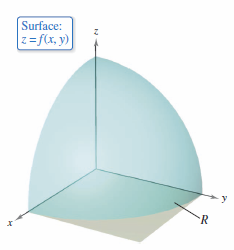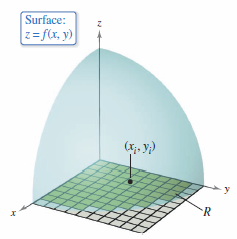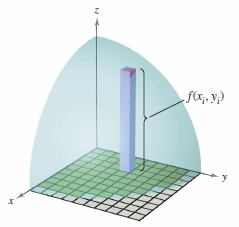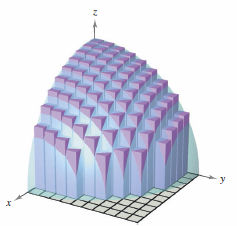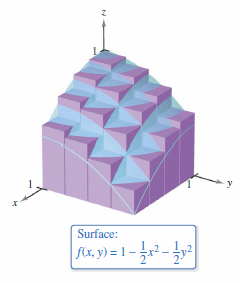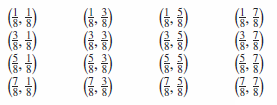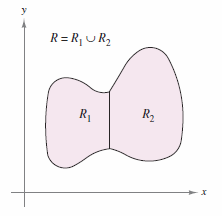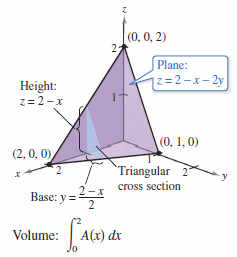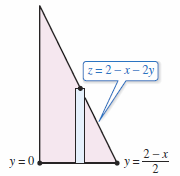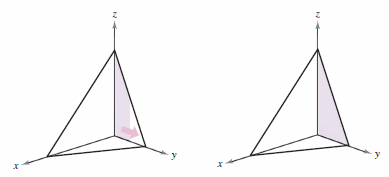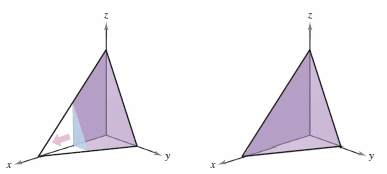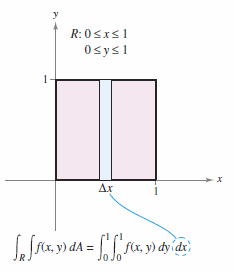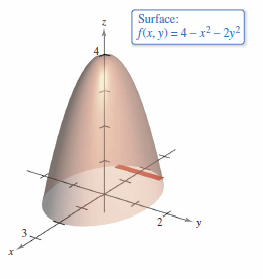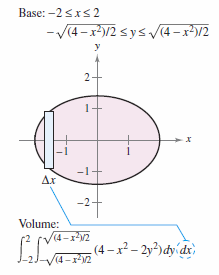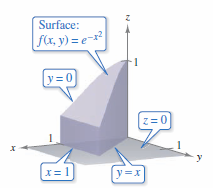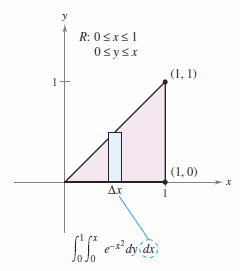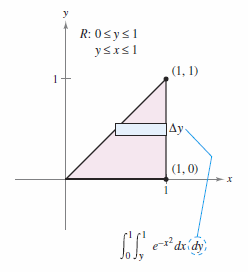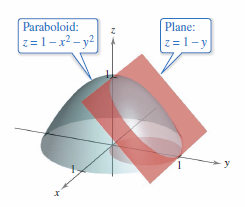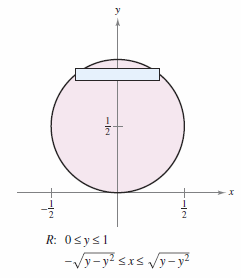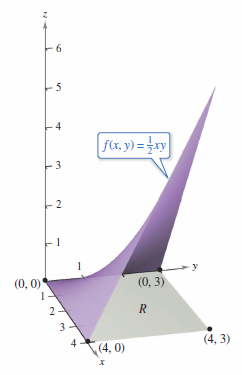Calculus III 14.02 Double Integrals and Volume
| Previous | Calculus III 14.01 Iterated Integrals and Area in the Plane |
| Next | Calculus III 14.03 Double Integrals in Polar Coordinates |
Contents
14.02 Double Integrals and Volume
- Use a double integral to describe the volume for a solid region.
- Evaluate a double integral as an iterated integral.
- Find the average value for a function over a region.
Double Integrals and Volumes for a Solid Region
|
|
The double integral for a function can determine the volume over a region in the plane. Consider a continuous function \(f\) such that \(f(x,y) \geqslant 0\) for all \((x,y)\) in a region \(R\) in the \(xy\)-plane. Find the volume for the solid region lying on the surface given by
and the \(xy\)-plane, as shown in Figure 14.2.1. In Chapter 1 the area under a curve was found by subdividing it into rectangles. The same technique can be extended here to three dimensions. Divide the region under the function into equal sized rectangles, as shown in Figure 14.2.2. The rectangles lying entirely within \(R\) form an inner partition' \(\Delta\), whose norm \(\| \Delta \|\) is defined as the length for the longest diagonal among the \(n\) rectangles. Choose a point \((x_{i},y_{i})\) in each rectangle and forms the rectangular prism whose height is
as shown in Figure 14.2.3. Because the area for the \(i\)th rectangle is
if follows that the volume for the \(i\)th prism is
The volume can be approximated by using Riemann sums for all \(n\) prisms,
as shown in Figure 14.2.4. This approximation can be improved by using smaller and smaller rectangles, as shown in Example 14.2.1.
|
Example 14.2.1 Approximating the Volume for a Solid
|
|
Approximate the volume for the solid lying between the paraboloid
and the square region \(R\) given by \( 0 \leqslant x \leqslant 1, \: 0 \leqslant y \leqslant 1\). Use a partition made from squares with each side 1/4 long. Because the area for each square is \(\Delta A_{i} = \frac{1}{16}\), the volume is approximated by the sum
This approximation is shown in Figure 14.2.6. The exact volume is \(2/3\), as described in Example 14.2.2. Using a finer partition, i.e., more squares, yields a better approximation. For example, a partition where the squares have \(1/10\) sides yields \(\approx 0.668\). |
Using finer partitions, as in Example 14.2.1, yields better approximations for the volume. This observation suggests that the exact volume is obtained by taking a limit. That is,
- $$Volume = \lim_{\| \Delta \| \rightarrow 0} \sum_{i=1}^{n} f(x_{i},y_{i}) \Delta A_{i}. $$
The precise meaning for this limit that it equals \(L\) if for every \(\varepsilon \geqslant 0\), there exists a \(\delta \geqslant 0 \) such that
- $$ \left| L - \lim_{\| \Delta \| \rightarrow 0} \sum_{i=1}^{n} f(x_{i},y_{i}) \Delta A_{i} \right| - \varepsilon$$
for all partitions \(\Delta\) in the plane region \(R\), that satisfy \(\| \Delta \| < \delta\) and for all possible choices for \(x_{i}\) and \(y_{i}\) in the \(i\)th region.
Using the limit for a Riemann sum to define volume is a special case for the limit to define a double integral. The general case does not require that the function be positive or continuous.
Definition 14.2.1 Double Integral
|
|
If \(f\) is defined on a closed, bounded region \(R\) in the \(xy\)-plane, then the double integral for \(f\) over \(R\) is
provided the limit exists. If the limit exists, then \(f\) is integrable over \(R\). A definite integral is occasionally referred to as a single integral. Sufficient conditions for the double integral for \(f\) on the region \(R\) to exist are that \(R\) can be written as a union among nonoverlapping subregions that are vertically or horizontally simple and that \(f\) is continuous on the region \(R\). This means that the intersection between two nonoverlapping regions is a set with zero area. In Figure 14.2.7, the area of the line segment common to \(R_{1}\) and \(R_{2}\) is zero. A double integral can be used to find the volume for a solid region that lies between the \(xy\)-plane and the surface given by \(z=f(x,y)\). |
Definition 14.2.2 Volume for a Solid Region
If \(f\) is integrable over a plane region \(R\) and \(f(x,y) \geqslant 0 \) for all \((x,y)\) in \(R\), then the volume for the solid region that lies above \(R\) and below the graph for \(f\) is
- $$V= \int_{R} \int f(x,y) \: dA $$
Theorem 14.2.1 Properties for Double Integrals
Let \(f\) and \(g\) be continuous over a closed, bounded plane region \(R\), and let \(c\) be a constant
- $$\textbf{1. } \int_{R} \int cf(x,y) \: dA = c\int_{R} \int f(x,y) \: dA$$
- $$\textbf{2. } \int_{R} \int [f(x,y) \pm g(x,y)] \: dA = \int_{R} \int f(x,y) \: dA \pm \int_{R} \int g(x,y) \: dA$$
- $$\textbf{3. } \int_{R} \int f(x,y) \: dA \geqslant 0 \text{, if }f(x,y) \geqslant 0$$
- $$\textbf{4. } \int_{R} \int f(x,y) \: dA \geqslant \int_{R} \int g(x,y) \: dA\text{, if }f(x,y) \geqslant g(x,y)$$
- $$\textbf{5. } \int_{R} \int f(x,y) \: dA = \int_{R_{1}} \int f(x,y) \: dA + \int_{R_{2}} \int f(x,y) \: dA \text{, where } R \text{ is the union between two overlapping subregions } R_{1} \text{ and } R_{2}.$$
Evaluating Double Integrals
|
|
Consider the solid region bounded by the plane
and the three coordinate planes, as shown in Figure 14.2.8. Each vertical cross section taken parallel to the \(yz\)-plane is a triangular region with base
and height
This implies that for some fixed value for \(x\), the area for the rectangular cross section is
By the Disk Method in Section 7.2 the volume is
This procedure works no matter how \(A(x)\) is obtained. Consider \(x\) as a constant and integrate \(z=2-x-2y\) from \(0\) to \((2-x)/2\) to produce
as shown in Figure 14.2.9. These results combine into an iterated integral
Imagine the integration as two sweeping motions. For the inner integration, a vertical line sweeps out the area for a cross section, as shown in Figure 14.2.10. For the outer integration, the triangular cross section sweeps out the volume, as shown in Figure 14.2.11. |
Theorem 14.2.2 Fubini's Theorem[1]
If \(R\) is a vertically or horizontally simple region and \(f\) is continuous on \(R\), then the double integral for \(f\) on \(R\) is equal to an iterated integral.
Let \(f\) be continuous on a plane region \(R\).
| 1. | If \(R\) is defined by \(a\leqslant x \leqslant b\) and \(g_{1}(x) \leqslant y \leqslant g_{2}(x)\), where \(g_{1}\) and \(g_{2}\) are continuous on \([a,b]\), then
$$\int_{R} \int f(x,y) \: d A = \int_{a}^{b} \int_{g_{1}(x)}^{g_{2}(x)} f(x,y) \:dy \: dx. \:\:\:\: \color{red}{ \text{Horizontally Simple }} $$ |
| 2. | If \(R\) is defined by \(c \leqslant y \leqslant d\) and \(h_{1}(y) \leqslant x \leqslant h_{2}(y)\), where \(h_{1}\) and \(h_{2}\) are continuous on \([c,d]\), then
$$\int_{R} \int f(x,y) \: d A = \int_{c}^{d} \int_{h_{1}(y)}^{h_{2}(y)} f(x,y) \:dx \: dy. \:\:\:\: \color{red}{ \text{Vertically Simple}}$$ |
Example 14.2.2 Evaluating a Double Integral using Fubini's Theorem
|
|
Evaluate
where \(R\) is the region described by
Solution Because the region \(R\) is a square, it is both vertically and horizontally simple, so any integration order will work. Choose \(dy \: dx\) by placing a vertical representative rectangle in the region, as shown in Figure 14.2.12.
This is an exact answer to the approximation in Example 14.2.1. While Example 14.2.1's approximation is good, 0.672 vs. 2/3, with only 16 squares in the partition. TThe error resulted because the centers of the square subregions were used as the points in the approximation. This is comparable to the Midpoint Rule approximation for a single integral. |
Example 14.2.3 Finding Volume by a Double Integral
|
|
The difficulty in evaluating a single definite integral usually depends on the function, not on the interval. This is a major difference between single and double integrals. Notice in this example that a change in the region \(R\) produces a much more difficult integration problem. Find the volume for the solid region bounded by the paraboloid \(z=4-x^{2}-2y^{2}\) and the \(xy\)-plane, as shown in Figure 14.2.13.
The volume is
|
In Examples 14.2.2 and 14.2.3, the problems could be solved with either integration order because the regions were both vertically and horizontally simple. The order \(dx\: dy\) would produced integrals with comparable difficulty. There are some occasions in when one integration order is much more convenient than the other, as shown in Example 14.2.4.
Example 14.2.4 Comparing Different Integration Orders
|
Find the volume for the solid region bounded by the surface
and the planes \(z=0, \: y=0, \: y=x\), and \(x=1\), as shown in Figure 14.2.15.
Setting up the corresponding iterated integrals reveals that the order \(dx \: dy\) requires the antiderivative
which is not an elementary function and painful to integrate. The other order, \(dy \: dx\), produces something easier.
|
Example 14.2.5 Volume for a Region Bounded by Two Surfaces
|
|
Find the volume for the solid region bounded above by the paraboloid
and below by the plane
as shown in Figure 14.2.18.
This slice through the paraboloid region \(R\) is a circle, as shown in Figure 14.2.19. Because the volume is the difference between the volume under the paraboloid and the volume under the plane, the formula is
|
Average Value for a Function
Recall from Section 4.4 that for a function \(f\) in one variable, the average value for \(f\) on the interval \([a,b]\) is
- $$ \frac{1}{b-a} \int_{a}^{b} f(x) \: dx. $$
Given a function \(f\) in two variables The average value for a function \(f\) in two variables over the plane region \(R\) is described in Definition 14.2.3.
Definition 14.2.3 Average Value for a Function Over a Region
If \(f\) is integrable over the plane region \(R\), then the average value for \(f\) over \(R\) is
- $$\text{Average value }= \frac{1}{A} \int_{R} \int f(x,y) \:dA $$
where \(A\) is the area for \(R\).
Example 14.2.6 Finding the Average Value for a Function
|
|
Find the average value for
over the plane region \(R\), where \(R\) is a rectangle with vertices
Solution The rectangular region for \(R\) has the area
as shown in Figure 14.2.20. The bounds for \(x\) are
and the bounds for \(y\) are
Applying Definition 14.2.3 produces
|
Internal Links
Parent Article: Calculus III 14 Multiple Integration
